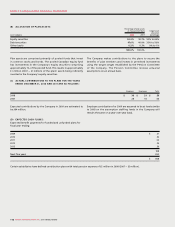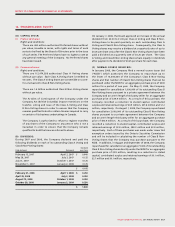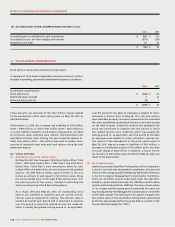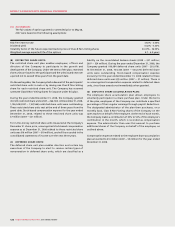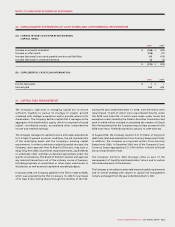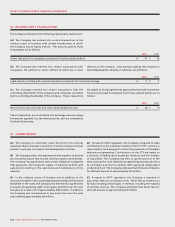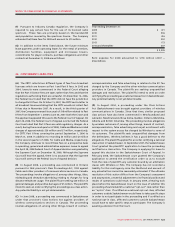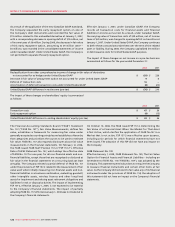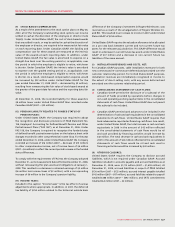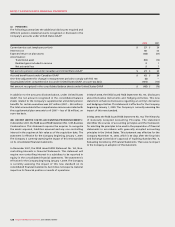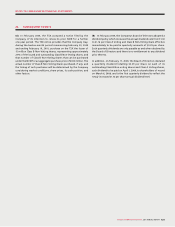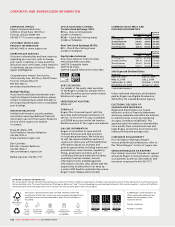Rogers 2008 Annual Report Download - page 130
Download and view the complete annual report
Please find page 130 of the 2008 Rogers annual report below. You can navigate through the pages in the report by either clicking on the pages listed below, or by using the keyword search tool below to find specific information within the annual report.
126 ROGERS COMMUNICATIONS INC. 2008 ANNUAL REPORT
NOTES TO CONSOLIDATED FINANCIAL STATEMENTS
2008 2007
Reclassification from other comprehensive income of change in fair value of derivatives
not accounted for as hedges under United States GAAP $ (93) $ 226
Decrease in fair value of prepayment option not accounted for under United States GAAP 9 6
Deferral of transaction costs 16 –
Amortization of deferred transaction costs under United States GAAP (8) (22)
United States GAAP difference in net income (pre-tax) $ (76) $ 210
As a result of the application of the new Canadian GAAP standards,
the Company separated the early repayment option on one of
the Company’s debt instruments and recorded the fair value of
$19 million related to this embedded derivative at January 1, 2007,
with a corresponding decrease in opening deficit of $13 million, net
of income taxes of $6 million. During 2008, the decrease in fair value
of this early repayment option, amounting to $9 million (2007 –
$6 million), was recorded in the consolidated statements of income
under Canadian GAAP. Under United States GAAP, the Company is
not permitted to separate the early repayment option.
Effective January 1, 2007, under Canadian GAAP, the Company
records all transaction costs for financial assets and financial
liabilities in income as incurred. As a result, under Canadian GAAP,
the carrying value of transaction costs of $39 million, net of income
taxes of $20 million, was charged to opening deficit on transition at
January 1, 2007. Under United States GAAP, the Company continues
to defer these costs and amortize them over the term of the related
asset or liability. During 2008, the Company capitalized $16 million
in debt issuance costs for United States GAAP purposes.
The impact of these changes on net income on a pre-tax basis are
summarized as follows for the year ended December 31:
The impact of these changes on shareholders’ equity is summarized
as follows:
2008 2007
Transaction costs $ 47 $ 39
Early repayment option (4) (13)
United States GAAP difference in ending shareholders’ equity (pre-tax) $ 43 $ 26
The Financial Accounting Standards Board (“FASB”) Statement
No. 157 (“FASB No. 157”), Fair Value Measurements, defines fair
value, establishes a framework for measuring fair value under
generally accepted accounting principles and establishes a hierarchy
that categorizes and prioritizes the sources to be used to estimate
fair value. FASB No. 157 also expands disclosures about fair value
measurements in the financial statements. On February 12, 2008,
the FASB issued FASB Staff Position 157-2 (“FSP 157-2”), Effective
Date of FASB Statement No. 157, which delays the effective date
of FASB No. 157 for one year, for all non-financial assets and non-
financial liabilities, except those that are recognized or disclosed at
fair value in the financial statements on a recurring basis (at least
annually). The Company elected a partial deferral of FASB No. 157
under the provisions of FSP 157-2 related to the measurement of fair
value used when initially measuring non-financial assets and non-
financial liabilities in a business combination, evaluating goodwill,
other intangible assets, wireless licences and other long-lived
assets for impairment and valuing asset retirement obligations and
liabilities for exit or disposal activities. The impact of implementing
FSP 157-2, effective January 1, 2009, is not expected to be material
to the Company’s financial statements. The impact of partially
adopting FASB No. 157 effective January 1, 2008 was not material to
the Company’s financial statements.
On October 10, 2008, the FASB issued FSP 157-3, Determining the
Fair Value of a Financial Asset When the Market for That Asset
is Not Active, which clarifies the application of FASB No.157 in a
Market that is not active. FSP 157-3 was effective upon issuance,
including prior periods for which financial statements have not
been issued. The adoption of this FSP did not have any impact on
the Company.
FASB Statement No. 159:
Effective January 1, 2008, FASB Statement No. 159, The Fair Value
Option for Financial Assets and Financial Liabilities - Including an
Amendment of SFAS No. 115 (“FASB No. 159”), was adopted by the
Company. This statement permits but does not require the Company
to measure financial instruments and certain other items at fair
value. As the Company did not elect to fair value any of its financial
instruments under the provisions of FASB No. 159, the adoption of
this statement did not have an impact on the Company’s financial
statements.


